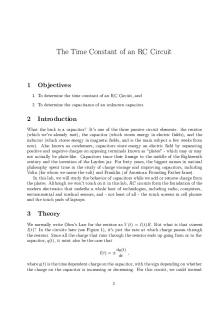Experiment 8 transient response of series rc circuit PDF

| Title | Experiment 8 transient response of series rc circuit |
|---|---|
| Author | x1y1 z1 |
| Course | General Phys / Electricity and Magnetism |
| Institution | San José State University |
| Pages | 12 |
| File Size | 966.3 KB |
| File Type | |
| Total Downloads | 65 |
| Total Views | 124 |
Summary
To study the transient response of series RC circuits using different values of R and C. Resistors - 2.2kΩ, 100kΩ, Capacitors - 0.1μF, 0.01μF...
Description
Submitted by:- Aditi Saxena 201433
EXPERIMENT 8 Aim:-To study the transient response of series RC circuits using different values of and C.
Component Required:-
Resistors - 2.2kΩ, 100kΩ, Capacitors - 0.1μF
0.01μF
Theory:A capacitor can store an electrical charge and energy. The voltage across the capacitor is related to the charge by the equation V=Q/C for steady-state values or expressed as an instantaneous value dv=dq/C we will study the transient response of the RC circuit, which is the response to a sudden change in voltage. In this experiment, we apply a pulse waveform to the RC circuit to analyze the transient response of the circuit. The pulse-width relative to a circuit’s time constant determines how it is affected by an RC circuit. Time Constant (τ): A measure of time required for certain changes in voltages and currents in RC and RL circuits. Generally, when the elapsed time exceeds fivetime constants (5τ) after switching has occurred, the currents and voltages have reached their final value, which is also called a steady-state response. The time constant of an RC circuit is the product of equivalent capacitance and the Thévenin resistance as viewed from the terminals of the equivalent capacitor.
A Pulse is a voltage or current that changes from one level to the other and back again. If a waveform’s high time equals its low time, it is called a square wave. The length of each cycle of a pulse train is termed it's period (T). The pulse width (tp) of an ideal square wave is equal to half the time. The relation between pulse width and frequency is then given by,
A series RC circuit is shown in Figure1. From Kirchoff’s laws, it can be shown that the charging voltage VC (t) across the capacitor is given by:
Where V is the applied source voltage to the circuit for t ≥ 0. τ =RC is the time constant. The response curve, showing capacitor charging for Series RC circuit to a step input with time axis normalized by τ is shown in Figure 2.
Figure 8.1 The discharge voltage for the capacitor is given by:
Where Vo is the initial voltage stored in the capacitor at t = 0, and τ=RC is time constant. The response curve is a decaying exponential as shown in Figure 3.
Procedure:1. Set up the circuit shown in Figure 8.1 with the component values R=2.2 kΩ and C=0.1μF. 2. Set the Function Generator to generate a 10Vp-p square wave and apply it as the input voltage to the circuit.
3. Observe the input square wave and output across the capacitor on the scope. Set th following properties of the scope: i. Right-click on the scope and select properties → plot. Over there select only Voltag and then click ok. ii. Right-click on the scope and select combine to combine the scope of input and outpu waveform.
4. Observe the response of the circuit for the following three cases and record the results a. tp >> 5⎮ : Set the frequency of the function generator output such that th capacitor has enough time to fully charge and discharge during each cycle of th square wave. So Let t p = 15⎮ and accordingly set the function generator frequenc using equation (2). The value you have found should be approximately 150 Hz Determine the time constant from the waveforms obtained on the CRO. (At t= ⎮ Vc (t) =0.63V from equation (3)). b. tp = 5⎮ : Set the frequency such that t p = 5⎮ (this should be 450 Hz). Since the puls width is exactly 5⎮, the capacitor should just be able to fully charge and discharge durin each pulse cycle. From the figure determine τ (see Figure 2 and Figure 5 below.) c. tp...
Similar Free PDFs

Series Circuit Problems Wkst
- 1 Pages

The Neuron - RC Circuit LAB
- 5 Pages

RC circuit Report - Lab R
- 2 Pages

Electrical circuit experiment
- 5 Pages

Experiment 6- Activity Series
- 7 Pages

Informe 8 Circuito RC
- 10 Pages

Response 8
- 3 Pages

Experiment 8
- 20 Pages

LAB 8 - Digital Circuit Design
- 12 Pages

Reading Response 8
- 1 Pages
Popular Institutions
- Tinajero National High School - Annex
- Politeknik Caltex Riau
- Yokohama City University
- SGT University
- University of Al-Qadisiyah
- Divine Word College of Vigan
- Techniek College Rotterdam
- Universidade de Santiago
- Universiti Teknologi MARA Cawangan Johor Kampus Pasir Gudang
- Poltekkes Kemenkes Yogyakarta
- Baguio City National High School
- Colegio san marcos
- preparatoria uno
- Centro de Bachillerato Tecnológico Industrial y de Servicios No. 107
- Dalian Maritime University
- Quang Trung Secondary School
- Colegio Tecnológico en Informática
- Corporación Regional de Educación Superior
- Grupo CEDVA
- Dar Al Uloom University
- Centro de Estudios Preuniversitarios de la Universidad Nacional de Ingeniería
- 上智大学
- Aakash International School, Nuna Majara
- San Felipe Neri Catholic School
- Kang Chiao International School - New Taipei City
- Misamis Occidental National High School
- Institución Educativa Escuela Normal Juan Ladrilleros
- Kolehiyo ng Pantukan
- Batanes State College
- Instituto Continental
- Sekolah Menengah Kejuruan Kesehatan Kaltara (Tarakan)
- Colegio de La Inmaculada Concepcion - Cebu





